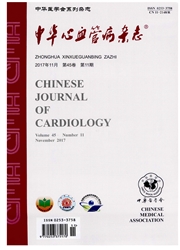

 中文摘要:
中文摘要:
目的评价磁共振成像(MRI)在冠心病陈旧性心肌梗死合并心功能不全患者诊断中的价值,并分析干细胞移植手术的疗效。方法20例冠心病陈旧性心肌梗死患者,男18例,女2例,年龄(59.5±10.1)岁,平均分成2组(每组10例),干细胞移植组行冠状动脉旁路移植术(CABG)+干细胞移植,对照组仅行CABG术,术前均行心脏MRI及双核素单光子发射计算机断层(SPECT)进行存活心肌显像检查,术后6个月复查心脏MRI。用MRI评价干细胞移植后左心功能改善及心脏MRI延迟增强显像判断左室存活心肌的准确性。结果两组左室射血分数(LVEF)均有明显改善,但手术前后变化值比较差异无统计学意义。干细胞移植组左室舒张末期容积(LVEDV)手术前后变化值为(9.91±39.50)ml,与对照组的(-22.34±31.35)ml比较,差异有统计学意义(P〈0.05);干细胞移植组室壁增厚率变化值高于对照组(11.40%±11.53%比2.27%±7.20%,P〈0.05),其余两组心功能参数变化值比较差异均无统计学意义。心脏MRI延迟增强显像与氟-18-脱氧葡萄糖(^18F-FDG)心肌代谢存活心肌显像具有较好的一致性,Kappa=0.446(P〈0.001)。以^18F—FDGSPECT心肌代谢显像为金标准,心脏MRI延迟增强显像敏感度为68.3%,特异度为92.5%。结论MRI能够准确判断冠心病陈旧性心肌梗死患者左室容积和功能,对心肌梗死后存活心肌的判断具有同^18F—FDGSPECT相近的特异性,但敏感性略低。MRI可用于心肌干细胞移植前诊断与移植后早期疗效的判定。
 英文摘要:
英文摘要:
Objective To evaluate the therapeutic effects of stem cell transplantation in heart failure patients with old myocardial infarction (OMI) by MRI. Methods Heart failure patients [ NYHA 2. 7 ±0. 7, male = 18, mean age (59. 5 ± 10. 1 )y] with OMI were randomly divided into 2 groups (group A: CABG+ stem cell transplantation, group B: CABG; n = 10 each). Left ventricular (LV) function was measured by MRI, viable myocardium was detected by ^18F-FDG myocardial metabolism imaging and late contrast-enhanced at baseline and 6 months post intervention. Results LVEF and LVEDV at baseline for group A were (20. 71 ± 6.09 ) % and ( 172. 73±32. 74) ml, and for group B were (27. 59±2. 31 ) % and (155. 13± 28.36)ml, respectively (P 〉 0. 05 ). The LVEF was equally improved in group A and B (mean 8. 63% vs. 10. 37%, P 〉 0. 05 ) while ALVEDV was significant higher in group A than that in group B [ (9. 91 ± 39. 50) ml vs. ( - 22. 34 ±31.35 ) ml, P 〈 0. 05 ]. Ventricular wall thickening ratio at 6 months post intervention was significantly higher in group A than that in group B [ ( 11.40±11.53) % vs. (2.27 ± 7.20)% ,P 〈 0. 05 ]. Late contrast-enhanced MRI results correlated with ^18F-FDG myocardial metabolism imaging SPECT well in assessment of myocardial viability ( kappa value: 0. 446, P 〈 0. 001 ; sensitivity: 68.3% and specificity: 92.5%). Conclusions Stem cell therapy on top of CABG aggravated LV remodeling in heart failure patients with old myocardial infarction. The specificity of MRI is similar to ^18F- FDG SPECT while the sensitivity is inferior to ISF-FDG SPECT on detecting viable myocardium.
 同期刊论文项目
同期刊论文项目
 同项目期刊论文
同项目期刊论文
 期刊信息
期刊信息
